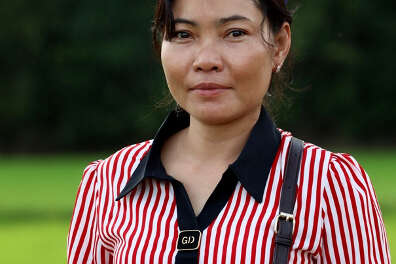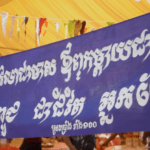
Photo courtesy: Facebook/ASHA Workers Union Haryana
Thousands of anganwadi (child-care) workers and helpers are on strike across multiple states in India. These women who are from marginalised backgrounds are India’s frontline warriors in the battle against hunger and child malnutrition. Despite this, they are not recognised as workers by the state and earn meagre honorariums.
Anganwadis or the child care centres are the foundational blocks of the Indian government’s Integrated Child Development Scheme (ICDS). This programme was initiated in 1975 to address child and maternal health and nutrition. However, in spite of this initiative, as per the latest Global Hunger Index-2021, a staggering 17.3 percent of the country’s children under five are wasted (those who are way too thin for his or her height), while 34.7 percent are stunted. Even though the accuracy of these projections has been questioned, the high prevalence of child malnutrition is an inescapable reality in India. This precarious condition has been exacerbated by the COVID pandemic.
The Anganwadi workers undertake a plethora of tasks, providing healthcare, supplementary nutrition to children upto six years and, also to pregnant and lactating mothers, pre-school informal education, and running community education and immunization programmes. Children upto six years coming to the anganwadis are also provided with mid day meals prepared by the women workers and helpers. This package of services provided by the anganwadi centres under the ICDS was designed to, ‘break the vicious cycle of malnutrition, morbidity, reduced learning capacity and mortality’. According to official data from 2018, nearly 1.36 million anganwadi centres are operational in the country which are run by an army of 1.29 million women anganwadi workers.
In recent years the anganwadi workers, along with other women working under various government schemes have become guardians of local level data, often deputed to conduct surveys and implement several government projects beyond their own responsibilities. During the pandemic , the functions of these women workers have increased manifold. Even though the anganwadi centres were closed during the lockdowns, the workers had to distribute dry ration to beneficiary households, carry out surveys of non-vaccinated people and engage in community awareness. These tasks were done without any additional protective equipment such as PPE kits or masks.
Despite performing such crucial functions, these women are not recognised as full-time employees but considered ‘part-time honorary workers’, reflecting the Indian State’s gender-based discrimination. By categorising them as voluntary workers, these ‘women scheme’ workers are denied an equitable wage and other social security nets.
The ICDS programme is run with a 60:40 division of costs between the Union and the State governments. Therefore, there are differentiated wages for these workers and helpers across the country. Till 2017, the central government’s sanctioned monthly honorarium for Anganwadi workers was a mere INR 3000, while the helpers received INR 1500. After an announcement by the Prime Minister in 2018 these honorariums were marginally raised to INR 4500 for anganwadi workers and INR 2250 for the helpers. In addition, the helpers were eligible for performance linked incentives of INR 250. Given the laborious work load, and inflation levels, these honorarium amounts were a complete travesty.
The last major struggle of the anganwadi workers and helpers in Delhi took place in 2017. Their three month long strike had then forced the state government to raise the honorarium to INR 9678 for anganwadi workers and INR 4839 for helpers. However, in the backdrop of the pandemic the Anganwadi Workers and Helpers union is demanding that the honorarium should be substantially raised to INR 25000 for the workers and INR 20000 for the helpers. The Delhi anganwadi workers have been on strike since 31 January of this year. Hundreds of workers have been demonstrating in front of the Chief Minister’s residence in the national capital.
The anganwadi workers and helpers in neighbouring state of Haryana have been on strike since early December of 2021. As a result, 26,000 anganwadis across all districts of the state are practically shut. The Haryana state government is yet to revise the payment of the workers and helpers in line with the central government’s announcement of 2018. Despite massive demonstrations and collective actions, the Haryana government announced a pitiable raise of INR 400. Rejecting the ‘gift’, the Joint Coordination Committee of Unions leading the struggle decided to continue their strike, which continues till date. The other major demands of the unions include skilled and unskilled worker status for the anganwadi workers and helpers respectively, introduction of employment benefits and pension scheme.
A series of repressive actions have been unleashed on the protesting anganwadi workers and helpers by the Haryana state government. By invoking the Essential Services Maintenance Act, the government has filed police cases against the protesters and retrenched close to 300 anganwadi workers. The union has alleged that the state government is now putting pressure on the protesters through their families and relatives, which has led to increasing tensions within the households. However, despite such repression amidst the raging COVID-19 third wave, the women anganwadi workers and helpers are maintaining constant night vigils in front of the residents of legislators.
Along with the anganwadi workers, other major scheme workers such as the ASHA workers and the Mid Day Meal workers have also been constantly waging struggles for equitable remuneration and social protections. Theys have been one of the most vocal voices against the central government’s move towards privatisation of social welfare programmes. Joint trade unions representing the scheme workers have raised concerns regarding the budgetary allocations for the social welfare programmes and the attempts of the government to introduce Direct Cash Benefits, targeting in the name of digitisation and sub-contracting services to big NGOs and corporates. It is feared that the privatisation drive will erode the foundations of the rights-based welfare schemes.
In this year’s budget for 2022-23, the ICDS programme has been re-branded as the POSHAN 2.0 programme, though with hardly any new allocations. In 2018, in order to digitise data and better tracking of beneficiaries, the central government introduced the POSHAN or Nutrition Tracker App and the Anganwadi workers were expected to feed in real time data on attendance, immunization, maternal health etc. However, this has proved to be an additional burden for the Anganwadi workers as they have to enter the data twice, once in the register and once on the App. The App also doesn’t work at all times due to server issues. Four years since the launch of the Tracker, the data on levels of malnutrition and other indicators is yet to be released by the government.
At a time when India is witnessing one of the highest rates of unemployment, and drastic reductions in women work participation in the labour force, the struggles of the women anganwadi workers and helpers, along with other scheme workers is a struggle for dignity. In recent times, and especially during the COVID pandemic these women have provided the most essential nutritional and health services. Thus, it is imperative to recognise their contributions, and grant them their demands of equitable pay and other employment benefits. A success in their present struggle will go a long way towards breaking gender discriminations in India’s workforce.







